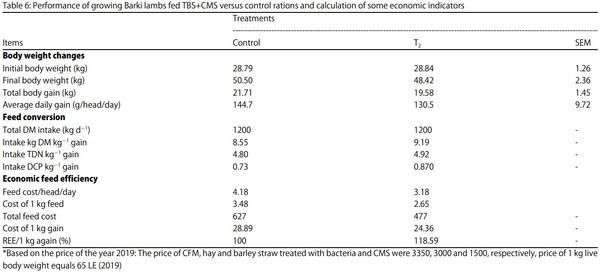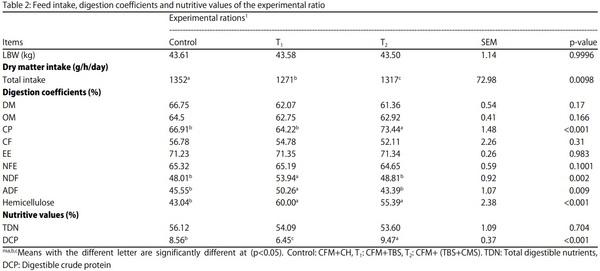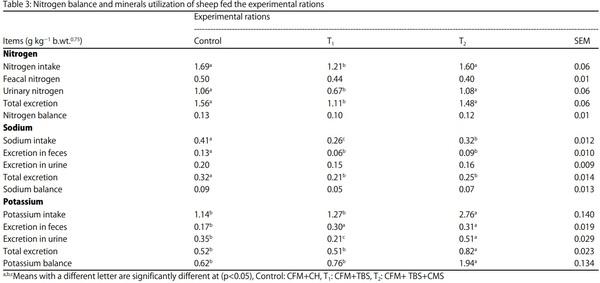INTRODUCTION
In arid and semi-arid regions small ruminants have a great importance1. Non-traditional feed resources, especially crop residues and farm byproducts, may be indispensable and may play an important role in meeting a need to help narrow the gap between demand and supply of feeding livestock2,3. In Egypt, Barley straw is considered one of the most important crop residues in the desert areas. Barley straw is poor-quality roughage because it is low in crude protein and poor in palatability. For it to be used as a useful feed for ruminant livestock, it requires proper pretreatment or supplementation with other nutrients 4. To increase the acceptability of straw to animals, there are various pretreatment processes (physical, chemical and biological) that may be used for increasing daily feed intake and improve digestion, The effects of these pretreatment methods on improving the digestibility of straw have been described4 .
The methods included breaking down of bonding structure between the polysaccharides (cellulose and hemicellulose) and lignin in the straw, extract and decomposition of the lignin to release polysaccharides and oligomers for better accessibility of ruminant microflora to improve the digestibility of straw, through biological treatment by bacteria and fungi, and/or their enzyme products4.
In addition, using Condensed Molasses Soluble (CMS) as a feed additive to rations could improve the nutritional value, the rate of palatability and the supplemental protein requirements of ruminants. The CMS is a byproduct that remains after the fermentation of molasses to produce ethanol, citric acid and yeast products5. Stemme et al. 6 reported that the forage consumption by animals has been increased with CMS supplementation and led to an increase in daily live weight gain. The objective of this study was to improve the nutritive value of barley straw by bacterial treatment (Cellulomonas cellulases bacteria), without or with CMS and to study the effect of TBS on nutrient digestibility, feeding value, rumen fermentation, some blood parameters and growth performance.
MATERIALS AND METHODS
Study location: This study was carried out at South Sinai Research Station (Ras Sudr) Desert Research Center, about 60 km south of the El-Shat area in Southern Sinai Governorate. It started in August, 2017-January, 2018. Chemical analysis was determined at Desert Research Center Laboratories, Cairo, Egypt.
Experimental treatments for barley straw: Barley straw was divided into two sections where humidity was increased to 65% by spraying water on barley straw, both sections were treated as follows:
-bacterial treatment: About 100 kg of the barley straw was treated with Cellulomonas cellulasea bacteria (TBS) by adding 10 L of bacterial culture plus 10 L molasses to 130 L of tap water. All mixed materials were pressed in clean plastic bags, each holding 33 kg, were sealed and stored in a chamber for 30-days at room temperature
-Bacterial and CMS treatment: A mixture of TBS and CMS (2:1 W/W respectively) was prepared
Treated barley straw, with or without adding CMS, were dried to stop the bacterial activity to avoid spoiling, till moisture content reached less than 10%, then repacked and stored until being used in the feeding trials.
Feed evaluation trial: The digestibility trial was carried out using twelve Barki rams aged 3-4 years with 43.57±0.58 kg average body weight. The animals were randomly divided into three similar groups (4 animals in each) based on average live body weight. The concentrate feed mixture (CFM: 20% cottonseed, 50% yellow corn, 30% corn bran, 1% salt, 0.3% vitamins and minerals premix, 2.7% calcium carbonate (CaCo3) was offered to all animals to cover 50% of their Dry Matter Intake (DMI). The experimental roughages, 50% of DM intake, were either clover hay as the control group (C), TBS (T1) and TBS plus CMS (T2). All animals were kept under the same managerial and environmental conditions. The feed intakes of rations were determined during the preliminary period and freshwater was available to all experimental groups all time. The animals were fed individually in metabolism cages. The digestibility trail lasted for 42 days, 35 days as an adaptation period and 7 days as a collection period for feces and urine. At the end of the digestibility trial, blood and rumen samples were drawn from all animals. Feeds, water intake and refused feeds were recorded daily and composite samples were kept for further chemical analysis.
Collection of samples: Feces were collected quantitatively daily and 10% was dried at 60°C to a constant weight and then ground and kept for lab analysis. Also, the daily collected urine samples were mixed with 100 mL of diluted sulfuric acid 10% and stored for nitrogen determination. Rumen liquor samples were obtained by using a stomach tube before morning feeding (zero time), 3 and 6 hrs post-feeding. Samples were strained through four folds of cheesecloth. The pH values were immediately measured by using a portable pH meter. The rumen liquor samples were stored in plastic bottles with a few drops of toluene and paraffin oil just to cover the surface and kept at a deep freeze (-20°C) for determination of total volatile fatty acids (TVFAs) and ammonia-nitrogen. Blood samples were taken from the jugular vein of each animal before feeding (zero time) and 6 hrs post-feeding. In the laboratory, blood samples were centrifuged at 3000 rpm for 20 min and the resulting serum was stocked at -20°C until use.
Chemical analysis
Feeds, feces and urine: Chemical analysis of feed, feces and urine were assayed by using methods of the Association of Official Analytical Chemists (AOAC) which used for the determination of Dry Matter (DM), Organic Matter (OM), Crude Fiber (CF), Crude Protein (CP), Ether Extract (EE) and Nitrogen-Free Extract (NFE) of the samples.
Neutral Detergent Fiber (NDF), acid Detergent Fiber (ADF) and Acid Detergent Lignin (ADL) were analyzed by Ankom200 Fiber Analyzer (Ankom Technology Corporation, Fairport, NY, USA) samples were analyzed using ANKOM commercial kits (Imported by the International Marketing Center, Hammamat El kobba, Cairo, Egypt) according to ANKOM Technology Method. Cellulose percentage was calculated by the difference between ADF and ADL and hemicellulose percentage was calculated by the difference between NDF and ADF Van Soest et al.7
Rumen liquor: Rumen liquor pH was determined using a portable pH meter (WPA, CD70, Cambridge, UK) Calibrated with Buffer solution PH 4,7. Rumen ammonia-N and TVFA's were determined using micro-Kjeldahl's method and steam distillation method as described by AOAC8.
Minerals analysis: The Na and K% were determined in the dry feed and feces. Their dry weights were determined by drying oven (Heraeus D-63450, kendro laboratory products, Hanau City, Germany) to a constant weight at 70°C for 72 hrs. After dryness, the feed and feces samples were milled and stored for analysis as reported. However, 0.5 g of the feed and feces powder or 1 mL of the urine and CMS solution were wet-digested with H2SO4-H2O2 mixture and determinations were carried out in the digested solution according to the method described by Jackson9 using Beckman Flame photometer (Elico CL378, Hyderabad, T.S., India).
Blood analysis: Serum samples were evaluated for different biochemical parameters by Spectrophotometer (UV-2300, Seya-Namioka, Japan) samples were analyzed using commercial kits (Produced by Egyptian Company for Biotechnology, Obour City, Cairo, Egypt) according to manufacturerʼs instructions. Like total protein and albumin (g dL−1) were measured according to Doumas et al. 10, respectively and globulin (g dL−1) was determined by the difference (TP-Alb), creatinin (mmol L−1) was determined according to Bartles et al. 11, Urea (mmol L−1) was determined according to Fawcett and Soctt12. The blood electrolytes in terms of sodium (meq L−1) Kruijswijk13 and potassium (mmol L−1) were determined according to Hillmann and Beyer14.
Growth performance trial: Ten growing Barki lambs with an average body weight of 28.82±1.26 and about four months old were divided randomly into two experimental groups (5-lambs each) according to their live body weight and fed on two experimental rations:
C: 50% CFM and 50% Egyptian clover hay (control)
T2: 50% CFM and 50% bacterial plus CMS treated barley straw
Statistical analysis: Differences among groups were checked using the GLM procedure (one-way analysis of variance). Duncan's new multiple range test15 was used to compare among means. The General Linear Model (GLM) procedure of SAS (2004) was employed. The following statistical model was adopted:
Yij = μ+Gi+eij
Where:
Yij = Observation
µ = Overall mean
eij = Mean standard error
RESULTS AND DISCUSSION
Chemical composition of the experimental feeds and feed ingredients: Chemical composition, Cell wall constituents, Gross Energy (GE) and some minerals contents of feedstuffs are shown in Table 1. The CMS is characterized by high contents of CP (21.02%), K (8.01%) and ash (26.36%). The value obtained for CP was higher than that obtained by Scull et al. 16 and Yeo et al. 17, where it was 12.39 and 12.58%, respectively. However, the present CP value is lower than those obtained by Yeo et al. 17, Hidalgo et al. 18, Oliveira et al. 19 and Zali et al. 20 where it was 9.2, 8.63 and 27.68%, respectively. Concerning ash and mineral contents of CMS, the values were in the range reported by Stemme et al. 5 and Zali et al. 20, where it was 23.2 and 33.5% for ash and 8.84 and 10.4% for K, respectively. But found higher Na contents (3.01 and 3.37%, respectively) than those in the present study (0.47%).
The bacterial Treatment of Barley Straw (TBS) increased CP, EE, NFE , Ash, GE, Na and K content as compared to Untreated Barley Straw (UBS) from 3.94, 1.03, 43.58, 17.49, 354, 0.30 and 1.37-7.85, 1.12, 47.14, 17.85, 359, 0.44 and 1.89, respectively. In contrast, the TBS decreased DM, CF, NDF, ADF and hemicellulose from 92.75, 33.96, 56.70, 38.33 and 18.37-91.63, 26.04, 54.62, 36.48 and 18.14, respectively. However, the percentage of OM was approximately equal. Our results were in agreement with Akinfemi et al. 22, who found a decrease in NDF, ADF and ADL,which may be for the effect of the extracellular enzymes secreted from microorganisms.
The microbeʼs carbohydrate as an energy source for the growth of microbes and this may be the reason of the decrease the content of crude fiber in treated materials. The results were confirmed by Kewan23 and Chalchissa and Arega24.
Comparing with untreated barley straw, the TBS+CMS treatment improved the CP, CF, NDF and ADF contents from 3.94, 33.96, 56.70 and 38.33%-12.04, 20.7, 44.4, 28.11%, respectively. Whereas, the GE value decreased from 354-312 Mcal kgG1 DM. Generally, the chemical composition of TBS+CMS and CH (Table 1) were nearly the same, with minor variations in some values. However, TBS+CMS showed better values of CP and CF contents than TBS.
Nutrients digestibility and nutritive values of the experiment rations: The Dry Matter Intake (DMI) of the experimental rations was shown in (Table 2). The DM intake ranged from 1271-1352 g/d. The mean values of total DMI in control and T2 groups were significantly (p< 0.05) higher than the T1 group, where animals in the control group recorded the highest value of DMI, compared to the other two groups.
The results agree with those reported by Chalchissa and Arega24, who found that biological treatments of barely straw for cows increased (p< 0.01) DMI by 30.5%, compared with these received untreated barley straw. In the same way, Gerimipour et al. 25 found that DMI was significantly higher in calves fed a diet with 10% vinasse compared to other treatments (p< 0.05).
The mean values of digestion coefficients and nutritive values of the experimental rations are shown in (Table 2). The digestibility of DM, OM, CF, EE and NFE did not differ (p< 0.05) among the experimental rations. Similar results were obtained by Chalchissa and Arega24 on biological treatment for different residues. CMS improved the apparent digestibility of fiber fraction which coincided with those reported by Zali et al. 20.
The TBS+CMS treatment enhanced the quantity of CP in the ration T2, so its CP digestibility was higher than that of the other rations being 73.44, 66.91 and 64.22% for T2, C and T1 groups, respectively. This finding may be attributed to double effects of CMS, either to C. cellulasea bacteria included in the treatment or to modification in rumen microorganisms, especially cellulolytic bacteria and rumen protozoa as found by Leontowicz et al. 26 when vinasse or CMS were included in the cattle rations. The digestibility coefficient of EE and NFE did not differ (p< 0.05) among the experimental groups.
The nutritive value of the experimental rations expressed as TDN was 56.12, 54.09 and 53.6% showed no significant differences. On the other hand, DCP values were higher (p< 0.05) for the T2 group (9.47%) and T1 group showed the lowest value (6.45%).
Nitrogen balance and some minerals utilization: Data on nitrogen and minerals utilization of sheep fed the experimental rations are shown in (Table 3). Animal fed the experimental ration showed the same trend for all N utilization criteria, expressed as g kg−1 b.wt.0.75. However, the T1 group revealed the lowest values (p< 0.05). These results agreed with those reported by Khir et al. 27 and OʼReilly28. When compared with similar groups (C and T2). Nitrogen balance was not significantly affected (p< 0.05) among the experimental groups.
The highest and significant values of sodium intake were recorded is all tested groups. On the other hand, the excretion in feces, excretion in urine, total excretion and sodium balance values were not significant among all groups.
Results in Table 3 showed that values of potassium utilization, intake, voided via feces and urine and balance were significantly higher (p< 0.05) for the T2 group compared with the other groups and these finding mainly due to the high potassium content in T2 ration as a result of including CMS in the ration.
Characterization of ruminal fermentation: Results in the Table 4 revealed no significant difference in ruminal pH among all experimental groups. T1 group recorded highest pH, followed by control and T2 groups. Generally, pH values were significantly (p< 0.05) low at 3 hrs post-feeding, except for T1 which was at 6 hrs post-feeding. Similar results were obtained by OʼReilly28 and Al-Samaraae et al. 29.
The average values of TVFA's were significantly (p< 0.05) different among the experimental groups, being 5.98, 6.58 and 6.66 mg/100 mL for C, T1 and T2, respectively. All groups revealed the lowest values of TVFA's before feeding and then increased to the maximum after 3 hrs post-feeding. This increase caused a reduction in pH values. Similar results were obtained by OʼReilly28 and Salem et al. 30. Moreover, Khir et al. 27, who reported that a higher concentration of TVFA's of biological treatment groups may be the result of altered rumen microbial population and microbial activity.
Data on ammonia nitrogen (NH3-N) concentrations presented in Table 4 showed no significant (p< 0.05) effect as a result of feeding sheep on the experimental treatments. Generally, the peak of NH3-N concentration was noticed at 3 hrs post-feeding for all the experimental groups. Overall means of (NH3-N) were comparable among the experimental groups although T2 was slightly higher than T1 and C. This finding might be due to high nitrogen content and consequently N intake (Table 3).
The results obtained in this study coincided with the findings of Iranmehr et al. 31, who reported that the addition of vinasse in diets increased (p< 0.05) the rumen NH3-N from 114 mg L−1 in the control group to 120 mg L−1 in the treatment group.
Blood serum parameters: Blood serum parameters of the experimental sheep are presented in Table 5. Generally, all the data of the blood metabolites were in the normal physiological range as reported by Jackson and Cockcroft32.
Serum total proteins and albumin (g dL−1) values were insignificantly (p> 0.05) differ among all groups and ranged from (7.04-7.3) and (2.87-3.05), respectively. However, serum globulin concentrations were higher (p< 0.05) in animals received C and T2, compared to T1, respectively being values (5.98 and 6.25 vs. 4.12 g dL−1), respectively. On the other hand, the values of creatinine were almost equal in the normal range. However, Serum urea nitrogen did not significantly (p> 0.05) differ among groups.
Blood serum Na and K concentration were insignificantly (p> 0.05) different among all groups and ranged from (145.2±2.21-149.2 ±4.72 meq L−1 and 4.29-5.36 mmol L−1), respectively but were all within the normal range.
Performance of growing barki lambs: Mean values of body weight criteria, initial weight, final weight, total gain and average daily gain as present in Table 6 indicated that lambs fed TBS+CMS ration revealed nearly similar values with the control group. The results agreed with the results of Maneerat et al. 33, who showed that the initial and final body weights the group fed bagasse-vinasse mixture with pineapple peel silage exhibited the highest average daily gain (p< 0.05). Moreover, Gerimipour et al. 25 found that calves fed a diet enriched with 10% vinasse compared to the control animals that attained significant results in final body weight, average DWG and DMI.



Feed conversion expressed as the amount (kg) of TDN and DCP kg consumed to produce one kg gain were different between the two experimental groups. In that regard, Moeini et al. 34 fed lambs on diets supplemented with 0, 5, 10 and 15% levels of CMS and found that no significant differences among treatments in DMI, final body weight, average daily gain and feed conversion ratio.
The economic efficiency (Table 6) was improved by the complete substitution of clover hay with bacteria plus CMS treated barley straw in sheep diets. The relative economic efficiency of producing one kg gain was better for the T2 group being higher by 18.2% than the control group. This is also in consonance with a study El-Zaiat et al. 35, who investigated partial replacement of soybean meal with dried vinasse rice (DVR) 500 g of the original concentration in growing lambs. The results indicated that the DVR500 diet reduced feed costs (p< 0.001).
In general, our data observed that TBS plus CMS (2:1W/W, respectively) it was the best treatments for barley straw, it improved the nutritional value, digestibility and palatability rates of barley straw but also DCP was significantly improved and reduce cost per 1 kg of growth. Therefore, the recommendation of this study is adding the CMS to poor quality roughage for improve the nutritive value and relative economic efficiency in sheep's production.
CONCLUSION
It can be concluded that total replacement of clover hay by TBS plus CMS in ration of Barki lambs improve the palatability, digestibility and feed intake and increases the feed efficiency by 18.56% and this may be considered good feeding strategies in feeding of Barki lambs in Arid and semi-arid regions.
This article was originally published in Pakistan Journal of Biological Sciences, 24: 252-260. ISSN 1028-8880. DOI: 10.3923/pjbs.2021.252.260. This is an Open Access article distributed under the terms of the Creative Commons Attribution License.













.jpg&w=3840&q=75)